tyre pressure RENAULT KANGOO 2017 X61 / 2.G Owner's Manual
[x] Cancel search | Manufacturer: RENAULT, Model Year: 2017, Model line: KANGOO, Model: RENAULT KANGOO 2017 X61 / 2.GPages: 260, PDF Size: 5.68 MB
Page 199 of 260
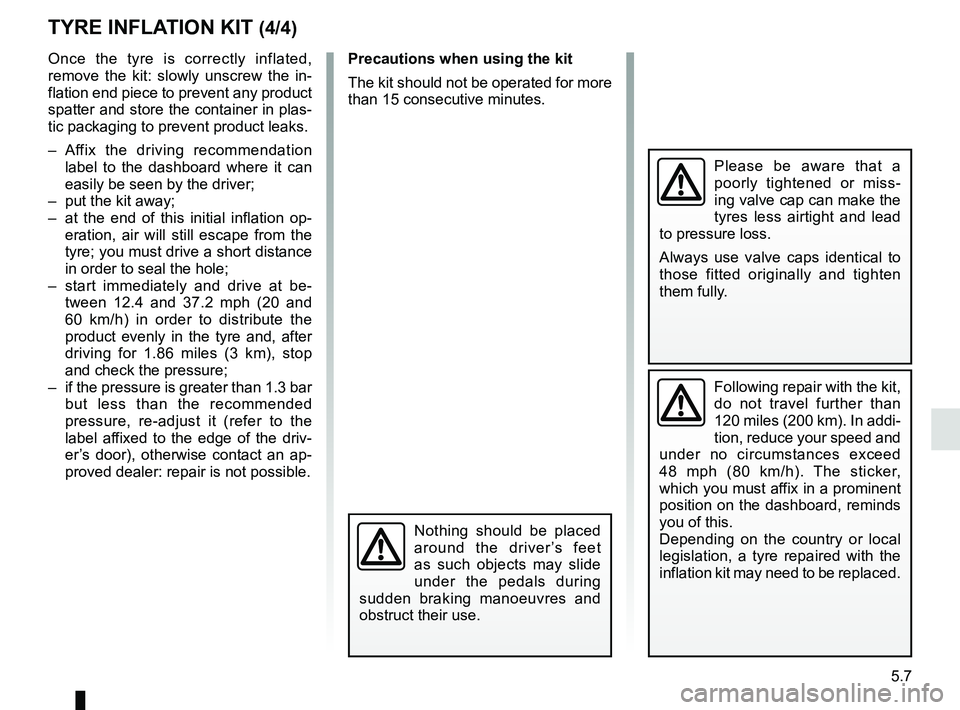
5.7
TYRE INFLATION KIT (4/4)
Please be aware that a
poorly tightened or miss-
ing valve cap can make the
tyres less airtight and lead
to pressure loss.
Always use valve caps identical to
those fitted originally and tighten
them fully.
Following repair with the kit,
do not travel further than
120 miles (200 km). In addi-
tion, reduce your speed and
under no circumstances exceed
48 mph (80 km/h). The sticker,
which you must affix in a prominent
position on the dashboard, reminds
you of this.
Depending on the country or local
legislation, a tyre repaired with the
inflation kit may need to be replaced.
Once the tyre is correctly inflated,
remove the kit: slowly unscrew the in-
flation end piece to prevent any product
spatter and store the container in plas-
tic packaging to prevent product leaks.
– Affix the driving recommendation label to the dashboard where it can
easily be seen by the driver;
– put the kit away;
– at the end of this initial inflation op- eration, air will still escape from the
tyre; you must drive a short distance
in order to seal the hole;
– start immediately and drive at be- tween 12.4 and 37.2 mph (20 and
60 km/h) in order to distribute the
product evenly in the tyre and, after
driving for 1.86 miles (3 km), stop
and check the pressure;
– if the pressure is greater than 1.3 bar but less than the recommended
pressure, re-adjust it (refer to the
label affixed to the edge of the driv-
er’s door), otherwise contact an ap-
proved dealer: repair is not possible. Precautions when using the kit
The kit should not be operated for more
than 15 consecutive minutes.
Nothing should be placed
around the driver’s feet
as such objects may slide
under the pedals during
sudden braking manoeuvres and
obstruct their use.
Page 204 of 260
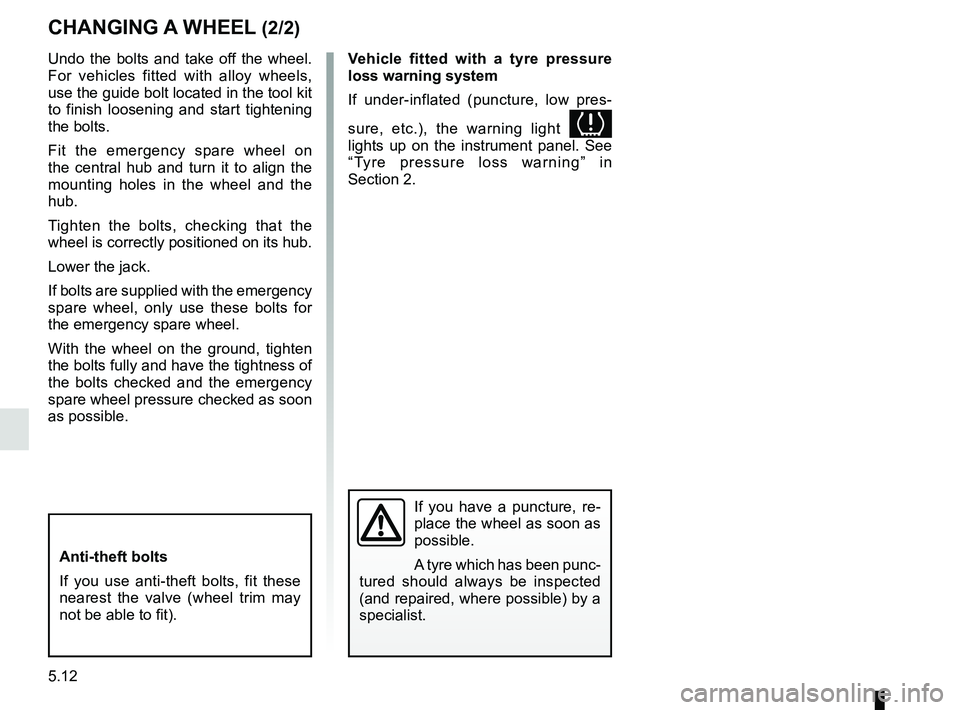
5.12
Undo the bolts and take off the wheel.
For vehicles fitted with alloy wheels,
use the guide bolt located in the tool kit
to finish loosening and start tightening
the bolts.
Fit the emergency spare wheel on
the central hub and turn it to align the
mounting holes in the wheel and the
hub.
Tighten the bolts, checking that the
wheel is correctly positioned on its hub.
Lower the jack.
If bolts are supplied with the emergency
spare wheel, only use these bolts for
the emergency spare wheel.
With the wheel on the ground, tighten
the bolts fully and have the tightness of
the bolts checked and the emergency
spare wheel pressure checked as soon
as possible.
CHANGING A WHEEL (2/2)
Anti-theft bolts
If you use anti-theft bolts, fit these
nearest the valve (wheel trim may
not be able to fit).
If you have a puncture, re-
place the wheel as soon as
possible.
A tyre which has been punc-
tured should always be inspected
(and repaired, where possible) by a
specialist.
Vehicle fitted with a tyre pressure
loss warning system
If under-inflated (puncture, low pres-
sure, etc.), the warning light
lights up on the instrument panel. See
“Tyre pressure loss warning” in
Section 2.
Page 206 of 260
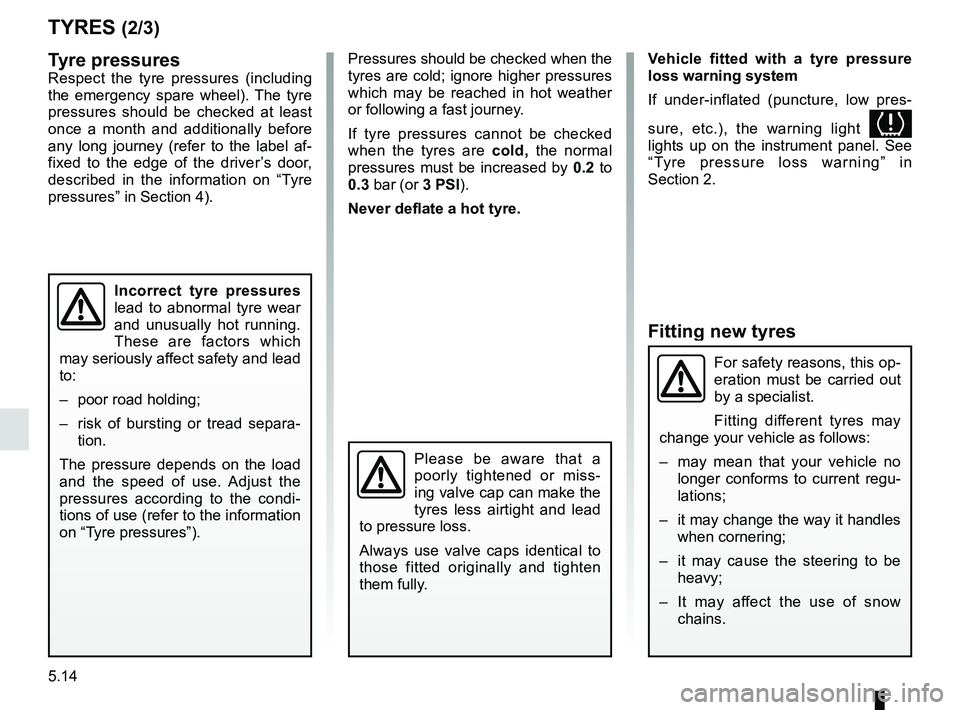
5.14
Fitting new tyres
TYRES (2/3)
Pressures should be checked when the
tyres are cold; ignore higher pressures
which may be reached in hot weather
or following a fast journey.
If tyre pressures cannot be checked
when the tyres are cold, the normal
pressures must be increased by 0.2 to
0.3 bar (or 3 PSI).
Never deflate a hot tyre.Tyre pressuresRespect the tyre pressures (including
the emergency spare wheel). The tyre
pressures should be checked at least
once a month and additionally before
any long journey (refer to the label af-
fixed to the edge of the driver’s door,
described in the information on “Tyre
pressures” in Section 4).
Incorrect tyre pressures
lead to abnormal tyre wear
and unusually hot running.
These are factors which
may seriously affect safety and lead
to:
– poor road holding;
– risk of bursting or tread separa- tion.
The pressure depends on the load
and the speed of use. Adjust the
pressures according to the condi-
tions of use (refer to the information
on “Tyre pressures”).
Please be aware that a
poorly tightened or miss-
ing valve cap can make the
tyres less airtight and lead
to pressure loss.
Always use valve caps identical to
those fitted originally and tighten
them fully.
For safety reasons, this op-
eration must be carried out
by a specialist.
Fitting different tyres may
change your vehicle as follows:
– may mean that your vehicle no longer conforms to current regu-
lations;
– it may change the way it handles when cornering;
– it may cause the steering to be heavy;
– It may affect the use of snow chains.
Vehicle fitted with a tyre pressure
loss warning system
If under-inflated (puncture, low pres-
sure, etc.), the warning light
lights up on the instrument panel. See
“Tyre pressure loss warning” in
Section 2.
Page 220 of 260
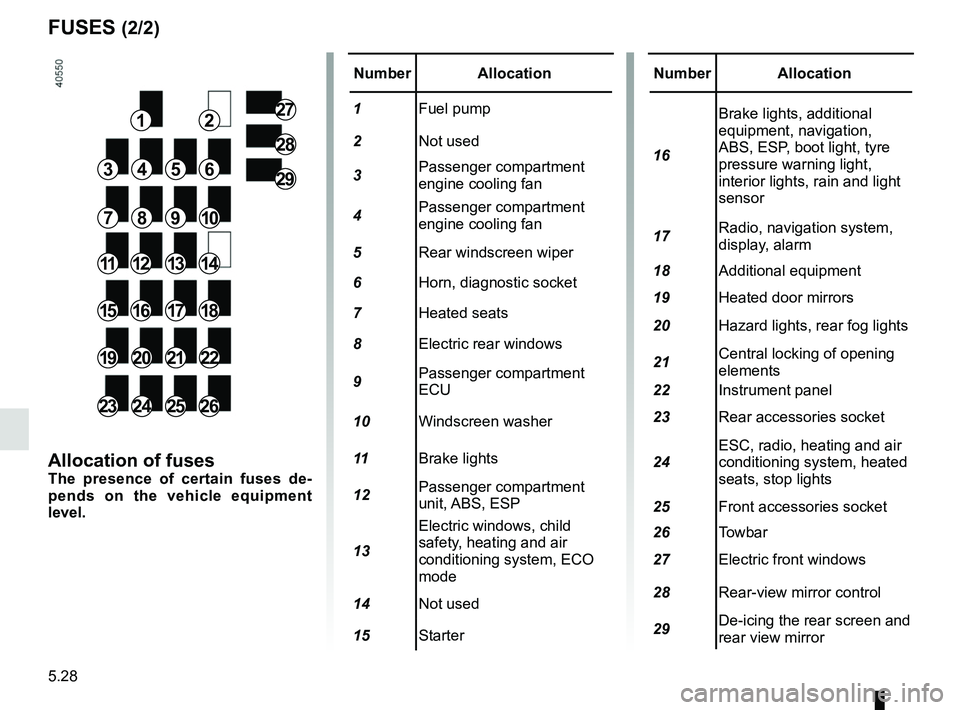
5.28
FUSES (2/2)
Number Allocation
1 Fuel pump
2 Not used
3 Passenger compartment
engine cooling fan
4 Passenger compartment
engine cooling fan
5 Rear windscreen wiper
6 Horn, diagnostic socket
7 Heated seats
8 Electric rear windows
9 Passenger compartment
ECU
10 Windscreen washer
11 Brake lights
12 Passenger compartment
unit, ABS, ESP
13 Electric windows, child
safety, heating and air
conditioning system, ECO
mode
14 Not used
15 StarterNumber Allocation
16 Brake lights, additional
equipment, navigation,
ABS, ESP, boot light, tyre
pressure warning light,
interior lights, rain and light
sensor
17 Radio, navigation system,
display, alarm
18 Additional equipment
19 Heated door mirrors
20 Hazard lights, rear fog lights
21 Central locking of opening
elements
22 Instrument panel
23 Rear accessories socket
24 ESC, radio, heating and air
conditioning system, heated
seats, stop lights
25 Front accessories socket
26 Towbar
27 Electric front windows
28 Rear-view mirror control
29 De-icing the rear screen and
rear view mirror
12
3456
78910
11121314
15161718
19202122
23242526
27
28
29
Allocation of fusesThe presence of certain fuses de-
pends on the vehicle equipment
level.
Page 230 of 260
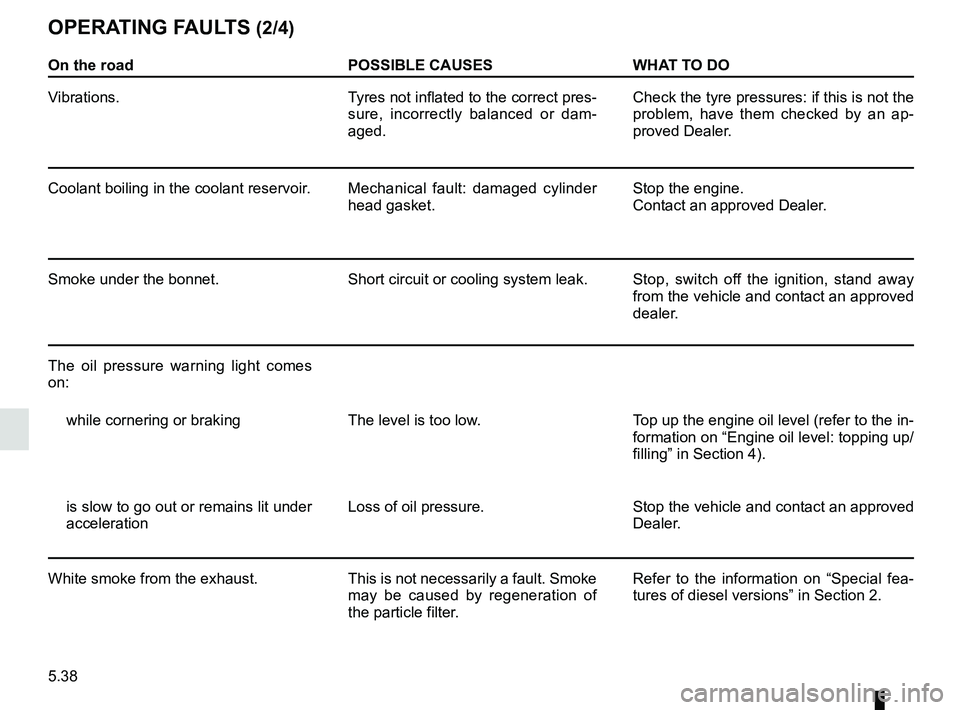
5.38
On the roadPOSSIBLE CAUSESWHAT TO DO
Vibrations. Tyres not inflated to the correct pres-
sure, incorrectly balanced or dam-
aged. Check the tyre pressures: if this is not the
problem, have them checked by an ap-
proved Dealer.
Coolant boiling in the coolant reservoir. Mechanical fault: damaged cylinder
head gasket.Stop the engine.
Contact an approved Dealer.
Smoke under the bonnet. Short circuit or cooling system leak.Stop, switch off the ignition, stand away
from the vehicle and contact an approved
dealer.
The oil pressure warning light comes
on: while cornering or braking The level is too low. Top up the engine oil level (refer to the in-
formation on “Engine oil level: topping up/
filling” in Section 4).
is slow to go out or remains lit under
acceleration Loss of oil pressure.
Stop the vehicle and contact an approved
Dealer.
White smoke from the exhaust. This is not necessarily a fault. Smoke
may be caused by regeneration of
the particle filter. Refer to the information on “Special fea-
tures of diesel versions” in Section 2.
OPERATING FAULTS (2/4)
Page 237 of 260
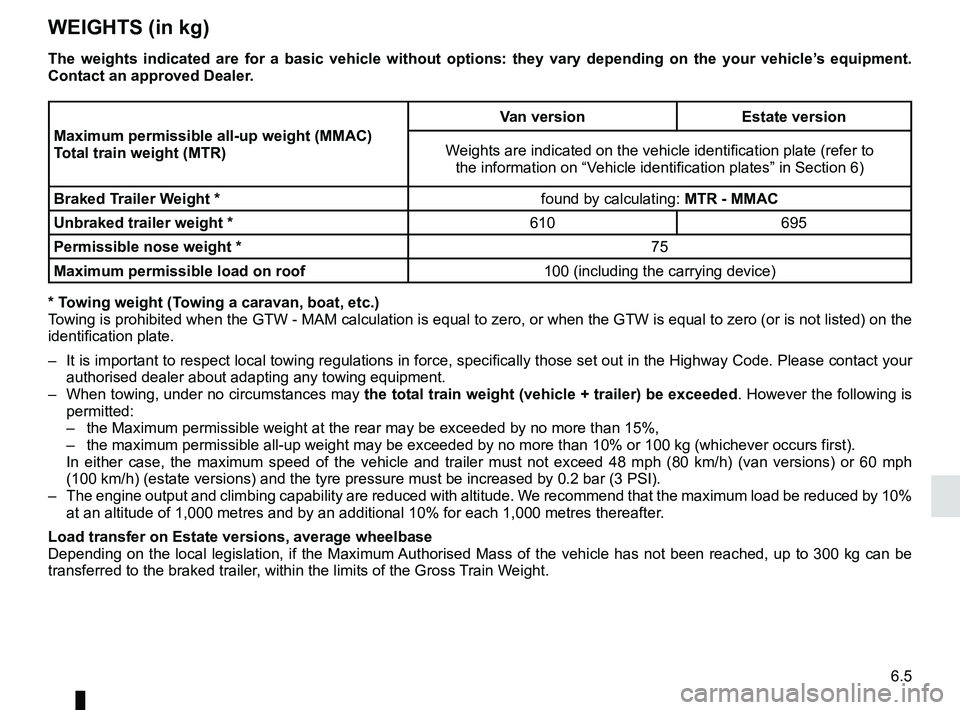
6.5
The weights indicated are for a basic vehicle without options: they vary\
depending on the your vehicle’s equipment.
Contact an approved Dealer.
Maximum permissible all-up weight (MMAC)
Total train weight (MTR)Van version Estate version
Weights are indicated on the vehicle identification plate (refer to the information on “Vehicle identification plates” in Section 6)
Braked Trailer Weight * found by calculating: MTR - MMAC
Unbraked trailer weight * 610 695
Permissible nose weight * 75
Maximum permissible load on roof 100 (including the carrying device)
* Towing weight (Towing a caravan, boat, etc.)
Towing is prohibited when the GTW - MAM calculation is equal to zero, or \
when the GTW is equal to zero (or is not listed) on th e
identification plate.
– It is important to respect local towing regulations in force, specifical\
ly those set out in the Highway Code. Please contact your
authorised dealer about adapting any towing equipment.
– When towing, under no circumstances may the total train weight (vehicle + trailer) be exceeded . However the following is
permitted:
– the Maximum permissible weight at the rear may be exceeded by no more th\
an 15%,
– the maximum permissible all-up weight may be exceeded by no more than 10\
% or 100 kg (whichever occurs first).
In either case, the maximum speed of the vehicle and trailer must not ex\
ceed 48 mph (80 km/h) (van versions) or 60 mph (100 km/h) (estate versions) and the tyre pressure must be increased\
by 0.2 bar (3 PSI).
– The engine output and climbing capability are reduced with altitude. We recommend that the maximum load be reduced by 10% at an altitude of 1,000 metres and by an additional 10% for each 1,000 m\
etres thereafter.
Load transfer on Estate versions, average wheelbase
Depending on the local legislation, if the Maximum Authorised Mass of the vehicle has not been reached, up to 300 kg can be\
transferred to the braked trailer, within the limits of the Gross Train Weight.
WEIGHTS (in kg)
Page 256 of 260
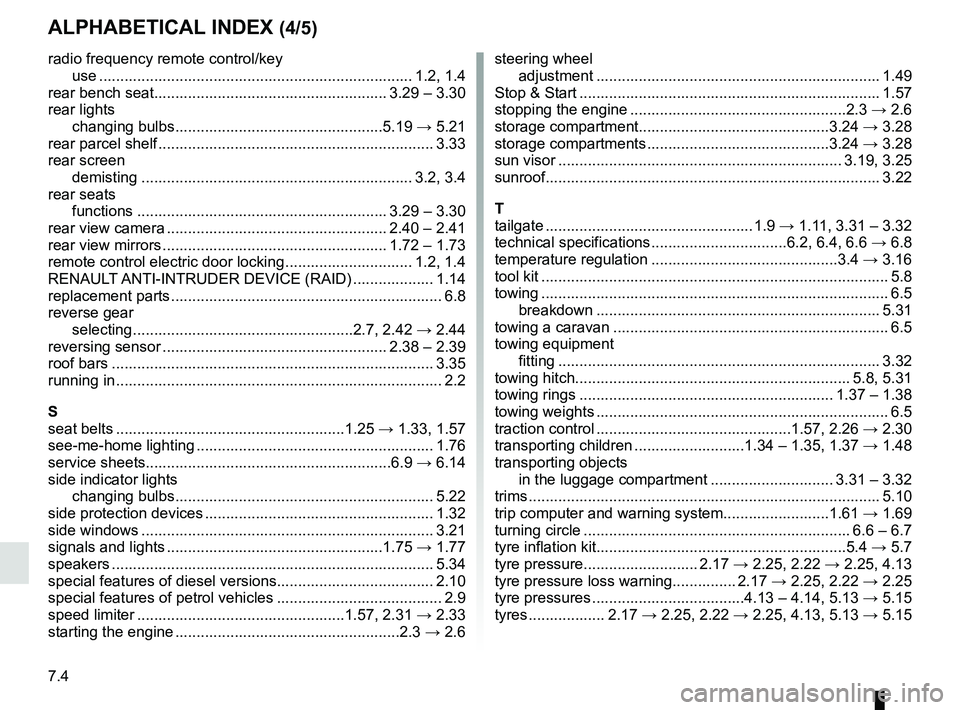
7.4
ALPHABETICAL INDEX (4/5)
radio frequency remote control/keyuse ....................................................................\
...... 1.2, 1.4
rear bench seat....................................................... 3.29 – 3.30
rear lights changing bulbs .................................................5.19 → 5.21
rear parcel shelf ................................................................. 3.33
rear screen demisting ..............................................................\
.. 3.2, 3.4
rear seats functions ........................................................... 3.29 – 3.30
rear view camera .................................................... 2.40 – 2.41
rear view mirrors ..................................................... 1.72 – 1.73
remote control electric door locking .............................. 1.2, 1.4
RENAULT ANTI-INTRUDER DEVICE (RAID) ................... 1.14
replacement parts ................................................................ 6.8
reverse gear selecting ....................................................2.7, 2.42 → 2.44
reversing sensor ..................................................... 2.38 – 2.39
roof bars ........................................................................\
.... 3.35
running in ........................................................................\
..... 2.2
S
seat belts ......................................................1.25 → 1.33, 1.57
see-me-home lighting ........................................................ 1.76
service sheets..........................................................6.9 → 6.14
side indicator lights changing bulbs ............................................................. 5.22
side protection devices ...................................................... 1.32
side windows ..................................................................... 3.21
signals and lights ...................................................1.75 → 1.77
speakers ...............................................................\
............. 5.34
special features of diesel versions..................................... 2.10
special features of petrol vehicles ....................................... 2.9
speed limiter .................................................1.57, 2.31 → 2.33
starting the engine .....................................................2.3 → 2.6steering wheel
adjustment .............................................................\
...... 1.49
Stop & Start ....................................................................... 1.57
stopping the engine ...................................................2.3 → 2.6
storage compartment.............................................3.24 → 3.28
storage compartments ...........................................3.24 → 3.28
sun visor ................................................................... 3.19, 3.25
sunroof........................................................................\
....... 3.22
T
tailgate ................................................. 1.9 → 1.11, 3.31 – 3.32
technical specifications ................................6.2, 6.4, 6.6 → 6.8
temperature regulation ............................................3.4 → 3.16
tool kit ........................................................................\
.......... 5.8
towing .................................................................\
................. 6.5 breakdown ..............................................................\
..... 5.31
towing a caravan ................................................................. 6.5
towing equipment fitting ................................................................\
............ 3.32
towing hitch................................................................. 5.8, 5.31
towing rings ............................................................ 1.37 – 1.38
towing weights ..................................................................... 6.5
traction control ..............................................1.57, 2.26 → 2.30
transporting children ..........................1.34 – 1.35, 1.37 → 1.48
transporting objects in the luggage compartment ............................. 3.31 – 3.32
trims ..................................................................\
................. 5.10
trip computer and warning system.........................1.61 → 1.69
turning circle ............................................................... 6.6 – 6.7
tyre inflation kit...........................................................5.4 → 5.7
tyre pressure........................... 2.17 → 2.25, 2.22 → 2.25, 4.13
tyre pressure loss warning............... 2.17 → 2.25, 2.22 → 2.25
tyre pressures ....................................4.13 – 4.14, 5.13 → 5.15
tyres .................. 2.17 → 2.25, 2.22 → 2.25, 4.13, 5.13 → 5.15